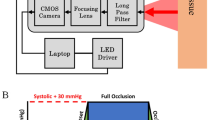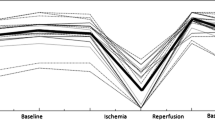Abstract
Near-infrared spectroscopy (NIRS) is an optical technique able to assess blood oxygen saturation (StO2) non-invasively. StO2 of peripheral blood (blood contained in small vessels in strict contact with tissue cells) reflects the adequacy of blood flow and O2 supply for tissue metabolism. Recent studies have tested the clinical utility of NIRS for studying peripheral microcirculation with the use of a NIRS probe, exploring a limited portion of hand skin (generally the thenar eminence), combined with vascular occlusion testing (VOT). In order to gain information from much larger tissue areas, the present study evaluates the possibility of using a NIRS two-dimensional (2D) camera for whole-hand imaging. Twelve healthy adults were tested. A NIRS camera was used to acquire the hemoglobin StO2 2D mapping of the whole-hand inner surface during VOT. Several parameters were calculated from the StO2 trend obtained from the NIRS image set, using two exemplifying regions of interest on the thenar eminence and the middle finger.






Similar content being viewed by others
References
De Backer, D., Ospina-Tascon, G., Sagado, D., Favory, R., Creteur, J., & Vincent, J. L. (2010). Monitoring the microcirculation in the critically ill patient: Current methods and future approaches. Applied Physiology in Intensive Care Medicine, 36, 1813–1825.
Herrick, A. L., & Clark, S. (1998). Quantifying digital vascular disease in patients with primary Raynaud’s phenomenon and systemic sclerosis. Annals of the Rheumatic Diseases, 57, 70–78.
Lima, A., & Bakker, J. (2012). Noninvasive monitoring of peripheral perfusion. In M. R. Pinsky, et al. (Eds.), Applied physiology in intensive care medicine: Physiological reviews and editorials (pp. 39–49). Berlin Heidelberg: Springer-Verlag.
De Blasi, R. A., Cope, M., Elwell, C., Safoue, F., & Ferrari, M. (1993). Noninvasive measurement of human forearm oxygen consumption by near infrared spectroscopy. European Journal of Applied Physiology, 67, 20–25.
Siafaka, A., Angelopoulos, E., Kritikos, K., Poriazi, M., Basios, N., Gerovasili, V., et al. (2007). Acute effects of smoking on skeletal muscle microcirculation monitored by near-infrared spectroscopy. Chest, 131, 1479–1485.
Lipcsey, M., Eastwood, G. M., Woinarski, N. C. Z., Bellomo, R., & Care, C. (2012). Near-infrared spectroscopy of the thenar eminence: Comparison of dynamic testing protocols. Critical Care and Resuscitation, 14, 142–147.
Ubbink, D. T., & Koopman, B. (2006). Near-infrared spectroscopy in the routine diagnostic work-up of patients with leg ischaemia. European Journal of Vascular and Endovascular Surgery, 31, 394–400.
Creteur, J., Carollo, T., Soldati, G., Buchele, G., De Backer, D., & Vincent, J. L. (2007). The prognostic value of muscle StO2 in septic patients. Intensive Care Medicine, 33, 1549–1556.
Doerschug, K. C., Delsing, A. S., Schmidt, G. A., & Haynes, W. G. (2007). Impairments in microvascular reactivity are related to organ failure in human sepsis. American Journal of Physiology Heart and Circulatory Physiology, 293, H1065–H1071.
Skarda, D. E., Mulier, K. E., Myers, D. E., Taylor, J. H., & Beilman, G. J. (2007). Dynamic near-infrared spectroscopy measurements in patients with severe sepsis. Shock, 27, 348–353.
Jöbsis, F. F. (1977). Noninvasive, infrared monitoring of cerebral and myocardial oxygen sufficiency and circulatory parameters. Science, 198, 1264–1267.
Kocsis, L., Herman, P., & Eke, A. (2006). The modified Beer-Lambert law revisited. Physics in Medicine & Biology, 51, 91–98.
Jue, T., & Masuda, K. (2013). Application of near infrared spectroscopy in biomedicine. New York: Springer Science & Business Media.
Lin, P., Lin, S., Penney, T., & Chen, J. (2009). Review: applications of near infrared spectroscopy and imaging for motor rehabilitation in stroke patients. Journal of Medical and Biological Engineering, 29, 210–221.
Scott, J. P., & Hoffman, G. M. (2014). Near-infrared spectroscopy: Exposing the dark (venous) side of the circulation. Paediatric Anaesthesia, 24, 74–88.
Ferrari, M., Muthalib, M., & Quaresima, V. (2011). The use of near-infrared spectroscopy in understanding skeletal muscle physiology: recent developments. Philosophical Transactions of the Royal Society of London A: Mathematical, Physical and Engineering Sciences, 369, 4577–4590.
Wyatt, J. S., Cope, M., Delpy, D. T., Richardson, C. E., Edwards, A. D., Wray, S., & Reynolds, E. O. (1990). Quantitation of cerebral blood volume in human infants by near-infrared spectroscopy. Journal of Applied Physiology, 68, 1086–1091.
Murkin, J. M., & Arango, M. (2009). Near-infrared spectroscopy as an index of brain and tissue oxygenation. British Journal of Anaesthesia, 103, 3–13.
Ferrari, M., & Quaresima, V. (2012). A brief review on the history of human functional near-infrared spectroscopy (fNIRS) development and fields of application. Neuroimage, 63, 921–935.
Van Beekvelt, M. C., Colier, W. N., Wevers, R. A., & Van Engelen, B. G. (2001). Performance of near-infrared spectroscopy in measuring local O(2) consumption and blood flow in skeletal muscle. Journal of Applied Physiology, 90, 511–519.
Binzoni, T., Cooper, C. E., Wittekind, A. L., Beneke, R., Elwell, C. E., Van De Ville, D., & Leung, T. S. (2010). A new method to measure local oxygen consumption in human skeletal muscle during dynamic exercise using near-infrared spectroscopy. Physiological Measurement, 31, 1257–1269.
Edwards, A. D., Richardson, C., van der Zee, P., Elwell, C., Wyatt, J. S., Cope, M., et al. (1993). Measurement of hemoglobin flow and blood flow by near-infrared spectroscopy. Journal of Applied Physiology, 75, 1884–1889.
Pichler, G., Urlesberger, B., Jirak, P., Zotter, H., Reiterer, E., Müller, W., & Borkenstein, M. (2004). Reduced forearm blood flow in children and adolescents with type 1 diabetes (measured by near-infrared spectroscopy). Diabetes Care, 27, 1942–1946.
Yoxall, W., & Weindling, A. M. (1997). Measurement of venous oxyhaemoglobin saturation in the adult human forearm by near infrared spectroscopy with venous occlusion. Medical & Biological Engineering & Computing, 35, 331–336.
Mozina, H., & Podbregar, M. (2010). Near-infrared spectroscopy during stagnant ischemia estimates central venous oxygen saturation and mixed venous oxygen saturation discrepancy in patients. Critical Care, 14, R42.
Allart, E., Olivier, N., Hovart, H., Thevenon, A., & Tiffreau, V. (2012). Evaluation of muscle oxygenation by near-infrared spectroscopy in patients with Becker muscular dystrophy. Neuromuscular Disorders, 22, 720–727.
Ambrozic, J., Lainscak, M., & Podbregar, M. (2013). Use of near infrared spectroscopy to asses remote ischemic preconditioning in skeletal muscle. Physiology Journal, 1–7, 2013.
Vardi, M., & Nini, A. (2008). Near-infrared spectroscopy for evaluation of peripheral vascular disease. A systematic review of literature. European Journal of Vascular and Endovascular Surgery, 35, 68–74.
Epstein, D., & Haghenbeck, K. T. (2014). Bedside assessment of tissue oxygen saturation monitoring in critically ill adults: An integrative review of the literature. Critical Care Research and Practice, 1–19, 2014.
Poeze, M. (2006). Tissue-oxygenation assessment using near-infrared spectroscopy during severe sepsis: Confounding effects of tissue edema on StO2 values. Intensive Care Medicine, 32, 788–789.
Gómez, H., Torres, A., Polanco, P., Kim, H. K., Zenker, S., Puyana, J. C., & Pinsky, M. R. (2008). Use of non-invasive NIRS during a vascular occlusion test to assess dynamic tissue O(2) saturation response. Intensive Care Medicine, 34, 1600–1607.
Parežnik, R., Knezevic, R., Voga, G., & Podbregar, M. (2006). Changes in muscle tissue oxygenation during stagnant ischemia in septic patients. Intensive Care Medicine, 32, 87–92.
Payen, A., Luengo, C., Heyer, L., Resche-Rigon, M., Kerever, S., Damoisel, C., & Losser, M. R. (2009). Is thenar tissue hemoglobin oxygen saturation in septic shock related to macrohemodynamic variables and outcome? Critical Care, 13, S6.
Välisuo, P., Kaartinen, I., Tuchin, V., & Alander, J. (2011). New closed-form approximation for skin chromophore mapping. Journal of Biomedial Optics, 16, 046012.
Gerovasili, V., Dimopoulos, S., Tzanis, G., Anastasiou-Nana, M., & Nanas, S. (2010). Utilizing the vascular occlusion technique with NIRS technology. International Journal of Industrial Ergonomics, 40, 218–222.
Boushel, R., & Piantadosi, C. A. (2000). Near-infrared spectroscopy for monitoring muscle oxygenation. Acta Physiologica Scandinavica, 168, 615–622.
Mayeur, C., Campard, S., Richard, C., & Teboul, J. L. (2011). Comparison of four different vascular occlusion tests for assessing reactive hyperemia using near-infrared spectroscopy. Critical Care Medicine, 39, 695–701.
Zuurbier, C. J., Van Iterson, M., & Ince, C. (1999). Functional heterogeneity of oxygen supply-consumption ratio in the heart. Cardiovascular Research, 44, 488–497.
Goldman, A., Bateman, R. M., & Ellis, C. G. (2006). Effect of decreased O2 supply on skeletal muscle oxygenation and O2 consumption during sepsis: role of heterogeneous capillary spacing and blood flow. American Journal of Physiology Heart and Circulatory Physiology, 290, H2277–H2285.
Bezemer, R., Lima, A., Myers, D., Klijn, E., Heger, M., Goedhart, P. T., et al. (2009). Assessment of tissue oxygen saturation during a vascular occlusion test using near-infrared spectroscopy: the role of probe spacing and measurement site studied in healthy volunteers. Critical Care, 13, S4.
Author information
Authors and Affiliations
Corresponding author
Rights and permissions
About this article
Cite this article
Hartwig, V., Marinelli, M., Rocco, F. et al. Assessment of Microvascular Function Using Near-Infrared Spectroscopic 2D Imaging of Whole Hand Combined with Vascular Occlusion Test. J. Med. Biol. Eng. 36, 87–95 (2016). https://doi.org/10.1007/s40846-016-0114-3
Received:
Accepted:
Published:
Issue Date:
DOI: https://doi.org/10.1007/s40846-016-0114-3




